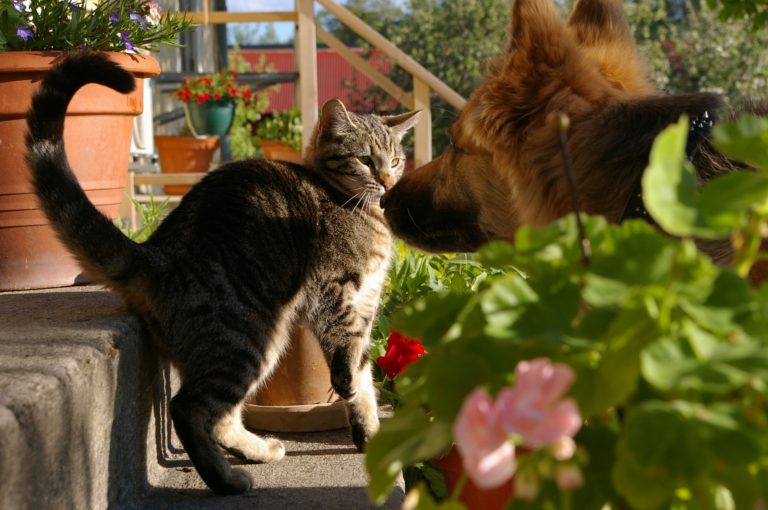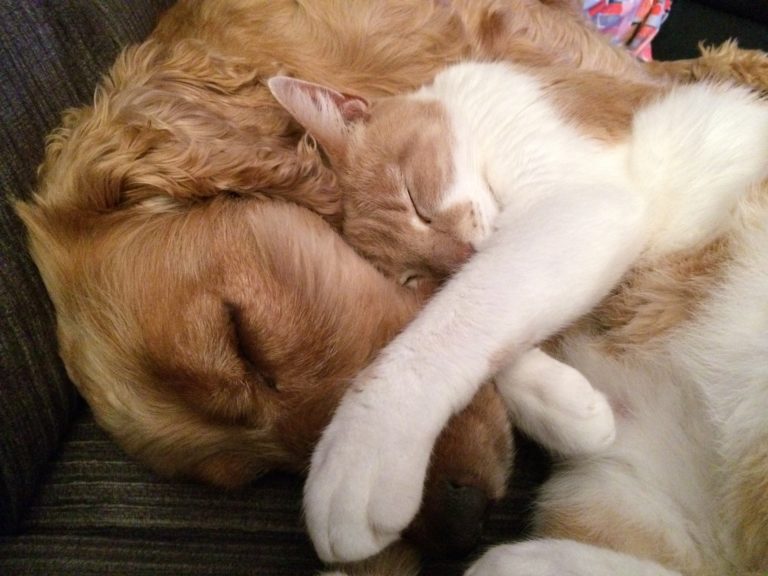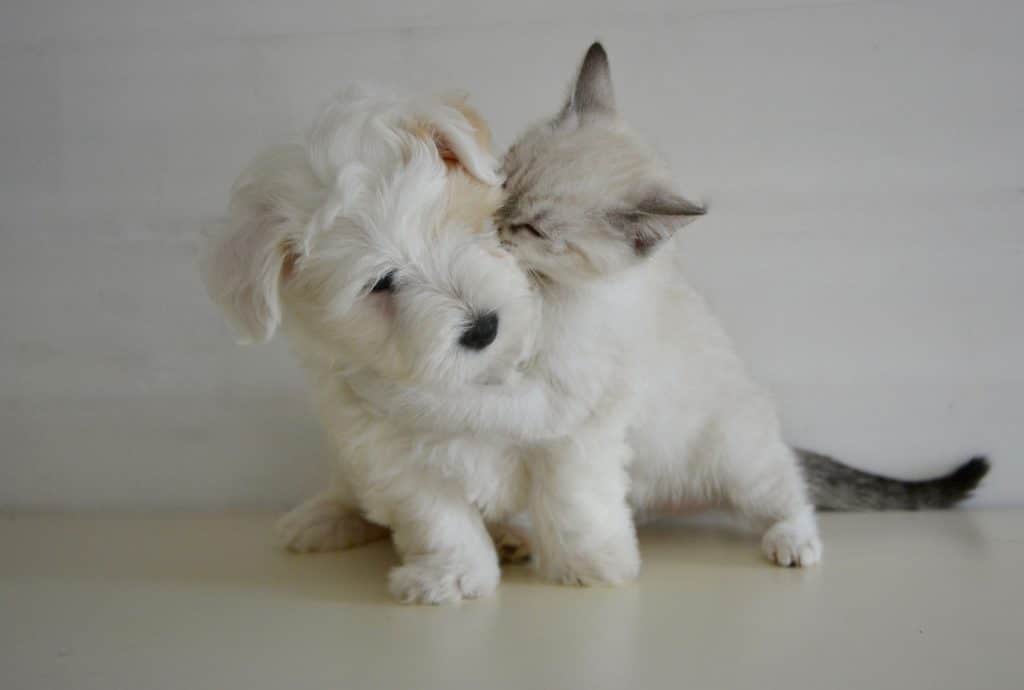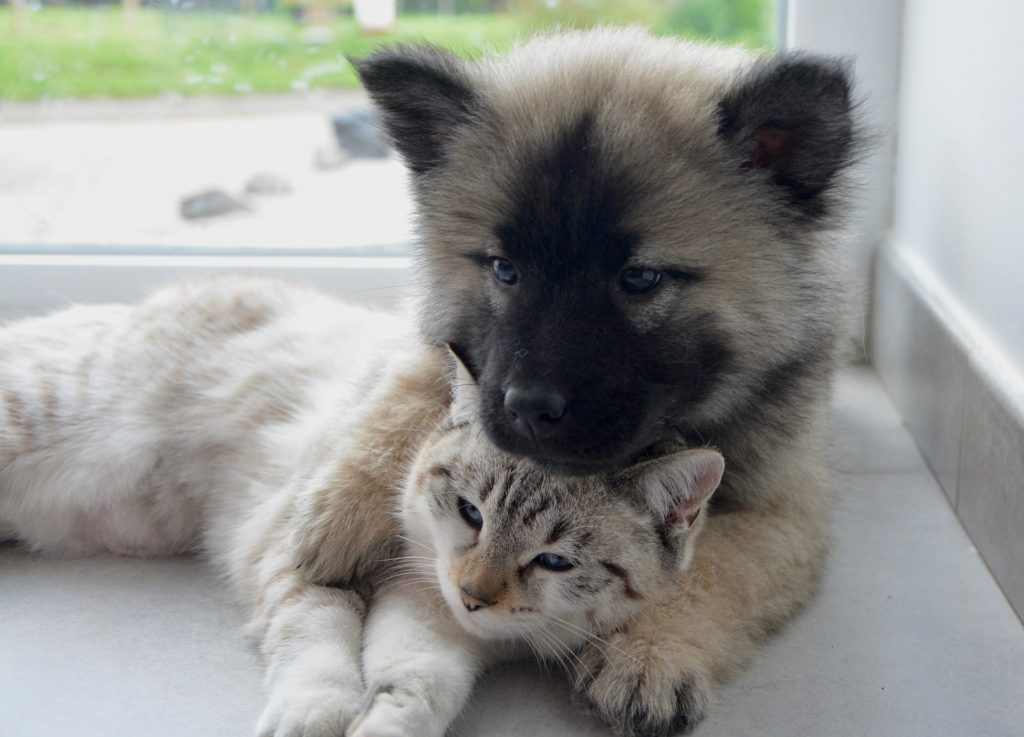How to Introduce a Dog to a Cat: 7 Tips
- Anja Boecker
- Updated: 2023-11-17
Dog and cat, the two most popular pets. Two worlds meet here. Dogs and cats are very different. But there are ways to get them used to each other. We reveal our top 7 tips.

Dogs and cats have different personalities. However, dogs and cats can live together and have a lot of fun. In the end, it's just a matter of getting used to it.
Dogs and Cats: Two Different Characters

When dogs and cats live together, two worlds usually collide, as the two breeds have different personalities and body languages.
➡ But with a little adjustment, dogs and cats can become best friends.
But before we give you some tips in this article, let's take a closer look at the characteristics of dogs and cats.
Cat Characteristics
The character of a cat is very complex. It is actually the opposite of a dog's character.
We are not saying that all cats have the same character. But different aspects can be found in different breeds.
While dogs are submissive to their owners, cats are difficult to dominate. Cats are considered independent creatures because they are often left to fend for themselves in the wild.
The ancestors of today's domestic cats are the ocelot or the hawk cat. They were also independent loners before they were domesticated.
Dog Characteristics
Unlike cats, dogs are not solitary animals, but live in packs in nature. In a pack, there is an alpha dog who dominates the group and makes decisions. This leader coordinates the pack in all situations.
The dog owner takes on this role when living with people. Dogs adapt quickly to human habits. Faster than cats. Different breeds also have different character traits.
In general, however, dogs are easier to dominate. Another difference between dogs and cats is that dogs are more active.
7 Tips to Get Dog and Cat Used to Each Other

1. Proper Preparation
Good preparation is essential. Because it can backfire if you let cats and dogs meet directly. That's why it's important to prepare.
A cat room is one option. It is also important that your dog and cat always have a place to retreat to.
While your dog can retreat to various places, velvet paws are a little more solitary. That's why you can create a cat room. This is a room that only your cat can enter.
Dogs and cats have a keen sense of smell. Unlike us humans, they have many more olfactory cells. Depending on the breed, a dog has at least 125 million olfactory cells.
Cats have about 60 million olfactory cells. Humans have only 20 million. You can get dogs and cats used to each other by exposing them to each other's scents.
Depending on whether the dog or cat is coming into the home, you can use a blanket or other piece of fabric. Your cat or dog can sleep on this cloth. Do this one night before the move. Then take the blanket and show it to the new resident.
Preparation Tips
Proper preparation is essential for a successful dog/cat reunion. Here are some tips to help you set the stage:
- Find out more: Understand the body language of dogs and cats in order to recognize signs of fear, aggression or discomfort in good time.
- Health Check: Make sure both animals are healthy and have all necessary vaccinations before meeting.
- Create a secure environment: Every pet should have a safe place to retreat to. For cats, it is important to be able to climb high, while dogs need their own area where they can rest.
- Introduce odors: Swap bedding or toys before the first meeting to get the animals used to each other's scents.
- Adjust feeding times: Feed the dog and cat separately, close together at first, to create positive associations.
- Provide the right equipment: A sturdy fence or protective barrier for initial eye contact and a leash for the dog are essential.
- Maintain routine: Try to keep both animals' routines as normal as possible to avoid additional stress.
- Desensitization: Get your dog used to wearing a muzzle if he is prone to impulsive behavior.
- Planning the first meeting: Choose a quiet moment without distractions for the first meeting.
- Behavior management: Practice basic commands like "sit," "stay," and "no" with your dog to maintain control in critical situations.
- Have a contingency plan: Know what to do if an encounter is negative, including how to safely separate the animals.
- Patience and a positive attitude: Stay calm and positive. Animals pick up on your emotions and stress or frustration can be transferred to them.
- Consider professional help: If you are not sure how to proceed or if there are problems, do not hesitate to consult an animal behaviorist.
With these preparations and a thoughtful approach, you can lay the groundwork for a successful integration of your pets.
2. Familiarize Yourself With Sounds
Getting your pet used to the sounds of the other pet is an important step in reducing stress and promoting a harmonious relationship between dog and cat. Here are some methods for getting pets used to each other's sounds:
Get the animals used to each other's sounds from a distance first. You can do this by keeping them in separate rooms while you work with the other animal, so they can hear the sounds from a safe distance.
It may be helpful to record the other animal's sounds and play them quietly around the house to help the animals get used to them. This can be barking, sniffing, meowing, or scratching on a tree.
Use controlled encounters to get the animals used to each other's immediate sounds. Keep the dog on a leash and release the cat at a safe distance while you observe how they react to the sounds.
If the animals remain calm while listening to each other, reward them with treats and praise. This reinforces the idea that listening to each other is a good thing.
If your dog becomes agitated when the cat meows, train him to remain calm by giving him a calming command and rewarding him when he relaxes. Start with quiet noises and gradually increase the volume until the animals no longer show fear or aggression.
If one of the animals reacts to the other's sounds, distract it with a toy or activity to prevent fear or aggression from building up. Repeat these exercises regularly so that the animals become accustomed to the sounds.
Watch for signs of stress or discomfort and reduce the volume or duration of exposure if necessary. Each animal has its own rate of learning and adaptation. Give them the time they need to adjust to the sounds.
3. First Visual Contacts
Use baby gates or keep the animals in separate rooms with a door that is cracked open. This allows them to see, smell, and hear each other without direct contact. This can stimulate curiosity while keeping them safe.
Feed the dog and cat at the same time on opposite sides of the fence. This creates an association between the presence of the other animal and something pleasant, such as feeding time.
4. Leash Your Dog
It is important that your dog is on a leash when you first meet him. This way he can't surprise the cat. This also gives your cat a chance to approach the dog on her own. This is important for the first meeting.
Let the cat decide if she wants to approach while the dog is on the leash. This gives the cat a sense of control and takes away her fear. The first meeting should not last too long. Ideally, 10 to 15 minutes.
Let the animals approach at their own pace. Do not force interaction and maintain control of the situation.
5. Treats for Dogs and Cats
Treats are a great way to help your dog and cat get acquainted. With the treat, your two friends will associate the first meeting with something positive.
Many strokes will increase this effect. Petting should not only be done at the first meeting.
6. The Number of People Present
Initially, all encounters should be supervised. This allows for intervention if an animal becomes frightened or aggressive. The number of people present should be limited to two. Too many people can overstimulate the animals.
Two people are ideal because each person can keep an eye on one of the pets. This makes it easier to pay attention to subtleties and assess the situation better.
7. Continuous Exercises
The mutual familiarization exercises should be repeated continuously. This will have the greatest effect and shorten the training period.
The acclimation period should be about one week. The acclimatization should be done not only once a day, but several times a day. 2 to 3 exercises are ideal.
Remember:
Do you notice that the dog or cat becomes aggressive during the encounter? Then you should end the encounter immediately.
It is important that you consistently enforce the boundaries. If there is any sign of aggression or fear, calmly separate the animals immediately. Try again later when both have calmed down.
Getting a young dog used to a cat differs in some important ways from getting an adult dog used to a cat:
Young dog
- Imprinting phase: Puppies are in a formative stage of life, and new experiences will shape their behavior for the rest of their lives. They are more open-minded and more likely to bond with other animals.
- Play instinct: Young dogs often have a strong play instinct and see a cat as a playmate rather than prey.
- Malleable behavior: Puppies are still in the learning phase, which means their behavior is easier to shape through training and socialization.
- Energy level: Young dogs tend to have more energy and can be more stressful to a cat if not properly supervised.
Adult dog
- Fixed behavior patterns: Adult dogs have already developed fixed patterns of behavior, and it can be more difficult to change existing habits.
- Previous experience: If an adult dog has had previous experience with cats, this may be positive or negative and affect the speed of adjustment.
- Territorial behavior: Adult dogs may be more territorial than puppies. The introduction of a cat into their territory can cause tension for some dogs.
- Patience: It may take more patience and time to get an adult dog used to a cat, as the adjustment is slower.
In both cases, a gradual approach with lots of patience and positive reinforcement is important. The differences are mainly in adaptability and energy levels.
Young dogs can learn and adapt more quickly, while adult dogs may require more time and management to safely and successfully socialize.
6 Absolute No-Nos
Now that we've given you a few tips, let's move on to the "don'ts" of settling in. A short list of these can be found here:
- Impatience
- Unsteady actions during the exercises
- Constant noise during the exercises
- Noise during the meeting (radio, TV, etc. should be turned off)
- Dog chasing the cat or vice versa
- Lack of empathy
- Do not leave the animals together unattended at first.
- Do not favor any of the animals
- Do not suppress the natural behavior of dogs and cats
Important Rules for Living Together with a Dog and Cat

After successful acclimatization, other rules must be followed. This is the only way to ensure peaceful coexistence in the long term.
1. Separate Feed
Separate feeding is a top priority in dog and cat care. Be sure to keep your pets' food separate.
This also means that dogs and cats are not allowed in each other's food bowls. Tip: Place the food bowls in different rooms.
2. Place the Litter Box in a Quiet Place
Cats like to retreat. This includes relieving themselves. That's why the litter box should be in a quiet place.
3. Equal Treatment
You should praise and reprimand your cat and dog equally. Neither should enjoy "puppy protection".
If both dog and cat do not respect each other's boundaries, you should reprimand them equally. The same goes for praise.
4. Tons of Patience
It can happen that your dog and cat get into a fight. It is important that you have a lot of patience. Try to be objective about the situation. Don't just take the dog's or cat's side.
Repeat positive encounters daily and slowly increase the duration of the encounters. Be patient and don't force things; some animals need more time to adjust than others.
Notes
The length of the habituation process varies greatly. For some animals it may take only a few days, for others it may take several weeks or months.
Every animal is different. Some dogs or cats gain confidence more quickly, while others are more timid or fearful by nature. Pay attention to your pets' individual cues and adjust the process accordingly.
If you find that the process is not progressing or there are serious conflicts, do not hesitate to consult a professional animal trainer or behaviorist.
Leaving a Dog and Cat Alone - When Is It Possible?
Leaving your dog or cat alone is a big step that needs to be well thought out and planned. There is no hard and fast rule as to when it is safe to leave a dog or cat alone, as each animal is unique and the relationship between them develops differently.
However, there are a few things that can help you decide when the time is right:
- Positive interactions: They have been observed to be calm and relaxed in each other's presence.
- No aggression: There were no signs of aggression or excessive fear when they were together for extended periods of time.
- Trust: Both animals show trust in each other by relaxing or even sleeping near each other.
- Independence: Each animal appears independent even in the presence of the other and does not show excessive concern or fear when the owner leaves the room.
- Slow increase in time: Start by leaving the animals alone for short periods of time and gradually increase the time if there are no problems.
- Safe environment: Make sure the environment is safe and that both animals have access to their retreats if they need to be separated.
- Monitoring: Consider installing a camera to watch the animals when you are away so you can intervene if problems arise.
- Plan B: Always have an emergency plan in case something unexpected happens, such as how to get home or who can intervene.
By keeping these points in mind and being patient, you can create a safe environment for your animals to feel comfortable in your absence. It's better to be careful and invest more time than to leave them alone too soon and risk conflict.
How Long Do Dogs and Cats Take To Get Used to Each Other?
The time it takes for a dog and cat to adjust to each other can vary greatly. Some pairs adapt in a matter of days, while others take weeks or even months. Several factors can affect this process:
- The personalities of the animals: Each animal has its own personality. Some are more social and adaptable, while others can be fearful or territorial.
- Previous experience: Animals that have a history of positive interactions with other species will gain trust more quickly.
- Age of the animals: Younger animals are often more adaptable than older ones. Puppies and kittens often adjust more quickly than adults.
- The acclimatization method: The manner in which the animals are acclimated plays a critical role. A gradual and patient introduction can speed up the process.
- The surroundings: A quiet and stress-free environment can make it easier to settle in.
- Regularity: Regular and positive interactions without incidents can build trust between the animals.
- The support of the owner: The ability to respond calmly and consistently and the owner's commitment to the process can also make a big difference.
- Individual differences: Sometimes two animals just get along and sometimes we realize that they may never become best friends, but they can learn to live together peacefully.
As you begin this process, it is important to watch for signs of stress or anxiety in the animals and seek professional help if necessary.
It is also important not to rush the process and force the animals to progress faster than they are ready. However, with patience and the right methods, it is perfectly possible to build a harmonious relationship between dog and cat.
Frequently Asked Questions
With a lot of patience and the right methods, almost any dog can be habituated to a cat. How long it takes depends on the character of the dog and the right habituation technique.
Ideally, the acclimation period is one week. However, it can take months for older animals or animals with a history of stress. The younger the animals, the faster they will accept each other.
It is best to start when the animals are young. Let the animals get to know each other's scents before they meet. Keep the dog on a leash during the first meeting. See our article for more tips.
Cats and dogs have fundamentally different characters and body language. It is also possible that the dog sees the cat as prey. As a result, the breeds may not get along right away and conflicts may arise.
My Conclusion

Dogs and cats are very different. That's why living together can sometimes be a little more difficult.
But living together is possible-and fun. With a little practice and our helpful tips, problems will soon be a thing of the past.
If you follow our tips and rules, nothing will get in the way of a great dog-cat friendship 😊.

My name is Anja Boecker, and I am a certified dog trainer and behavior consultant. With these articles, I want to help you to understand your dog better and to build an inseparable bond.
Share Now:

